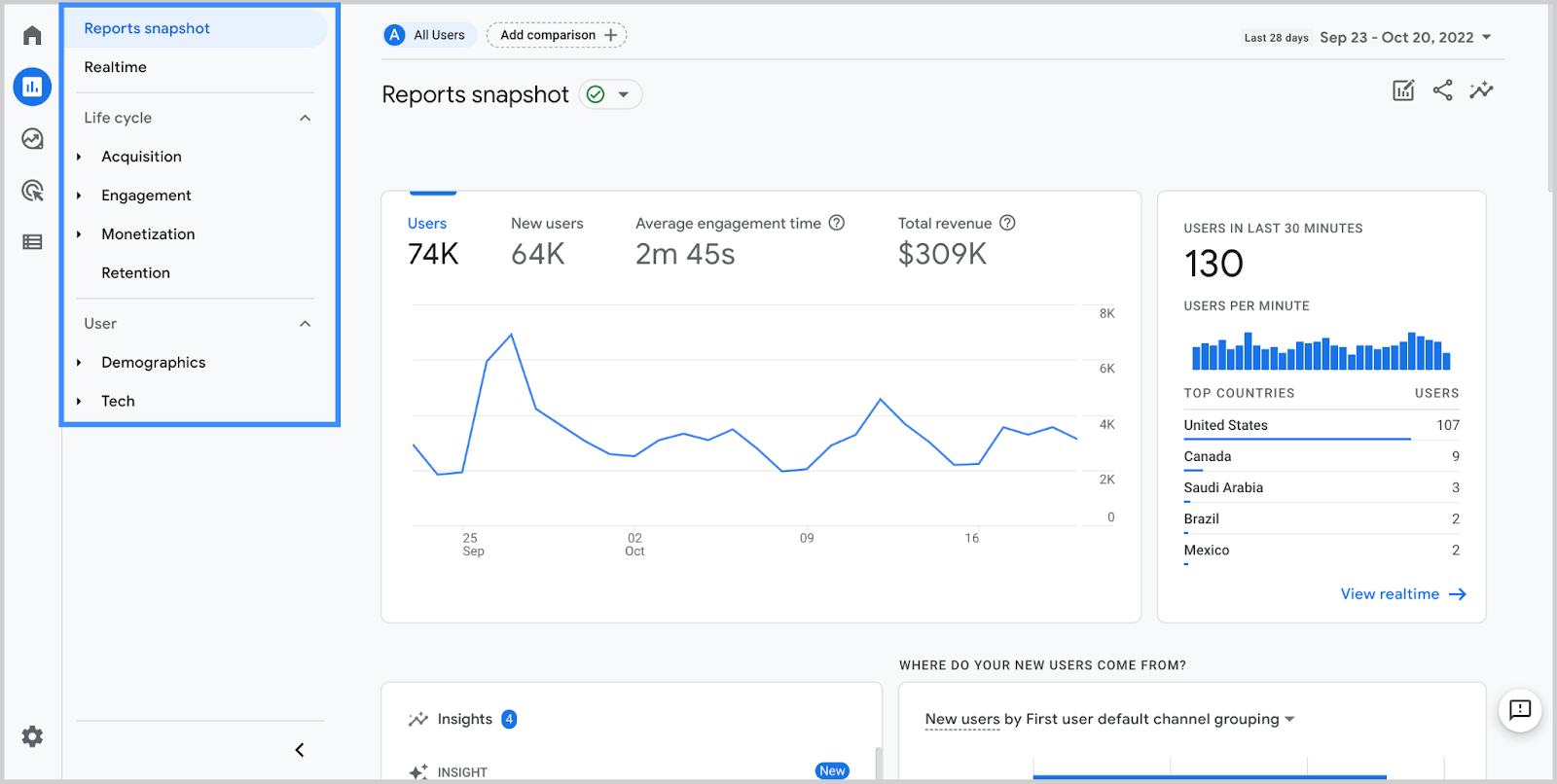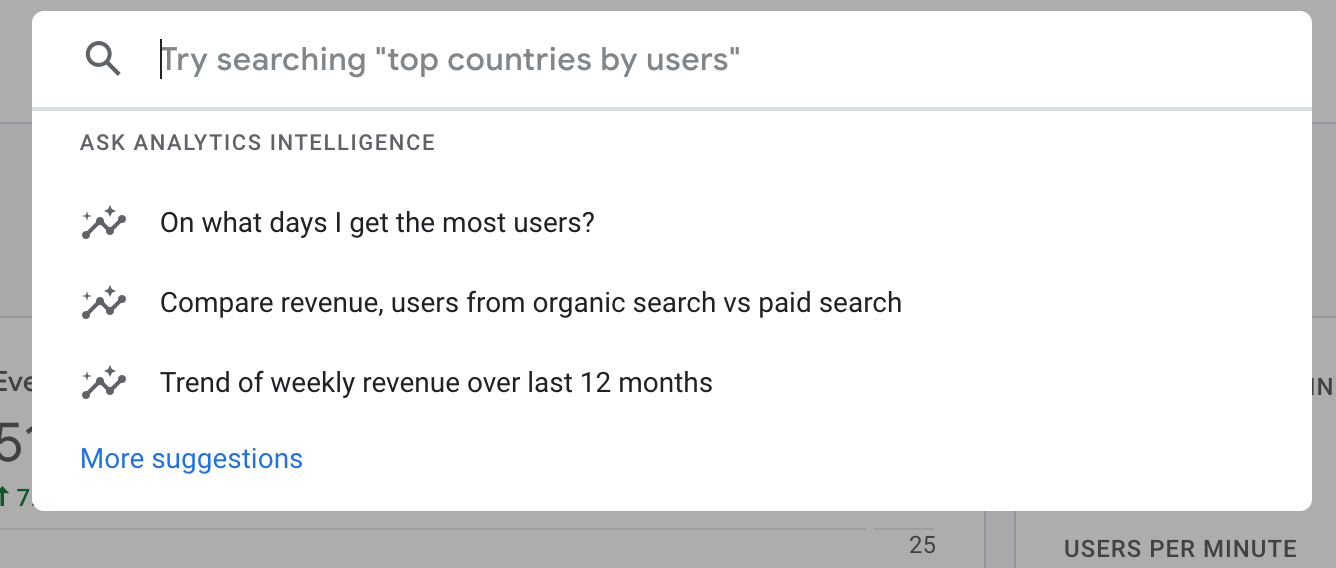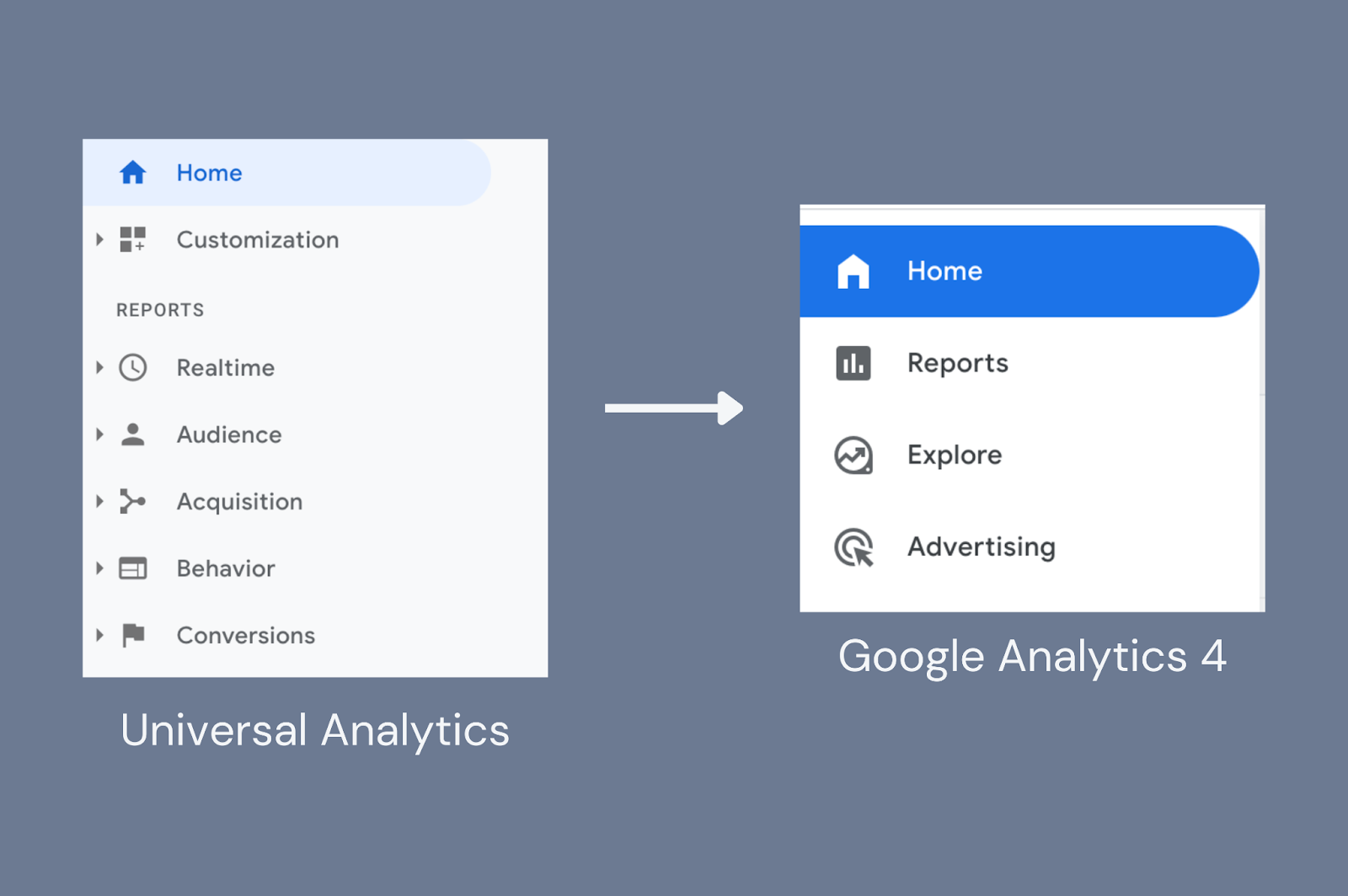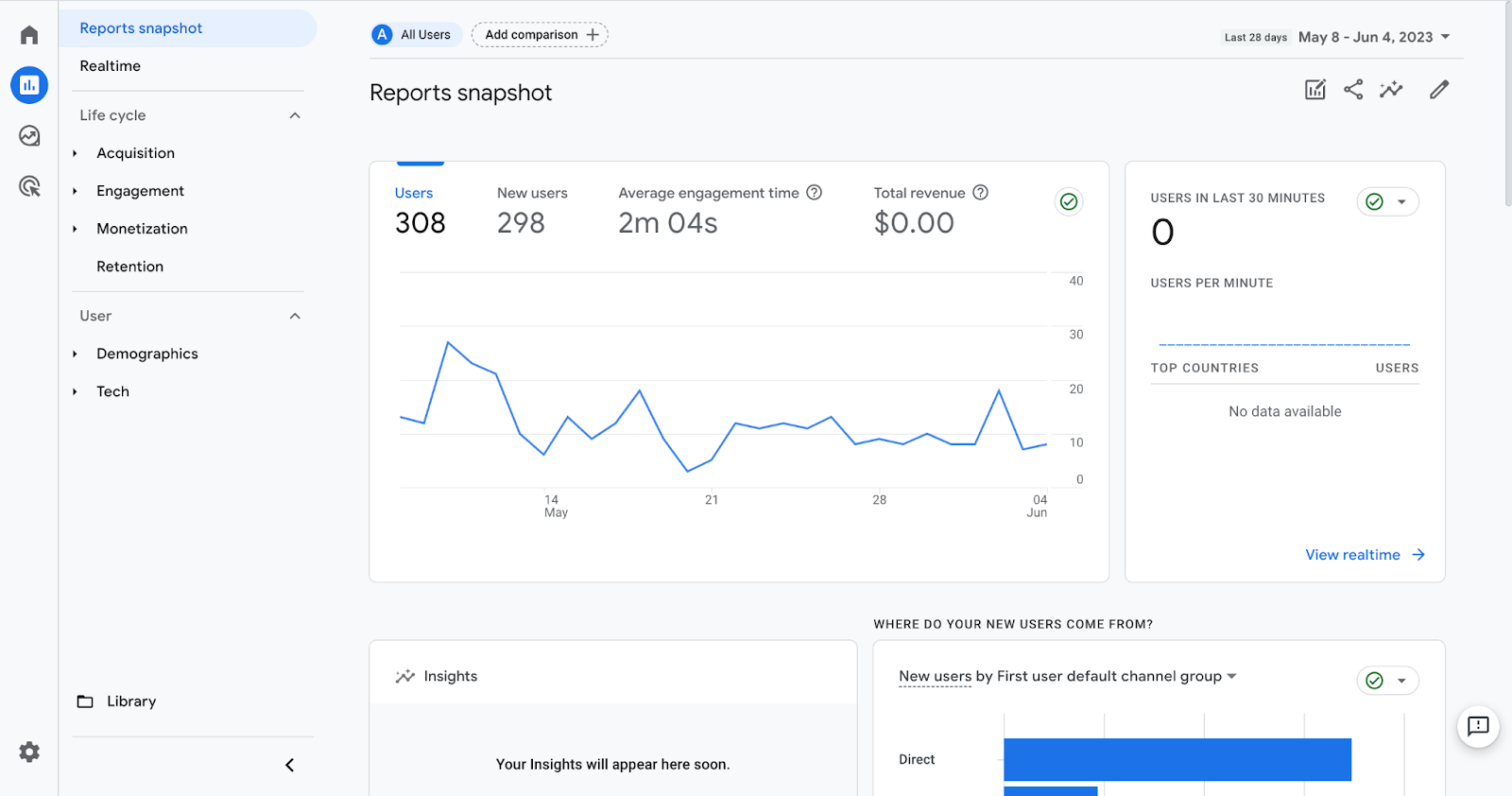For a few years now, Google Analytics has been encouraging users to make the switch from Universal Analytics to Google Analytics 4, which is set to replace Universal Analytics come July 2023. Though the date to switch is quickly approaching, many people have been slow to adopt the switch to track their website data. Since this change will be here sooner than we know it, let’s take a dive into what Google Analytics 4 is, some of the changes to analytics you can anticipate, and how you can successfully set up Google Analytics 4 on your Webflow website.
What Is Google Analytics 4?
Exploring the big change coming to your website analytics in July 2023

If you’ve used Google Analytics before, you’ve more than likely been using Universal Analytics. Google first released Universal Analytics (UA) in 2013, so it’s been around for quite some time now. But, as of July 1, 2023, Universal Analytics will become completely obsolete as it’s replaced by Google Analytics 4.
Google first introduced Google Analytics 4 (GA4) in October 2020 with the notion that this would in time replace Universal Analytics. Since then, we’ve all been able to use UA and GA4 in tandem or even just UA exclusively. Now that UA is quickly approaching its expiration date, it’s time to make the switch to GA4 if you haven’t done so already.
Especially if you’ve mastered UA, your first interactions with GA4 might be a bit jarring. Much of what you’ve become accustomed to in UA is either gone or very different. With lots of new features and many changes, it might take you a bit of time to get used to your new toolkit. Love it or hate it, though, GA4 is here to stay. So, let’s talk about some of the changes you can expect when you make the switch.
Google Analytics 4 vs Universal Analytics: New Features In GA4
Get familiar with some of the new tools you’ll have in Google Analytics 4

Google Analytics 4 does things a bit differently than you may be used to with Universal Analytics. From how data is reported and stored to how you actually analyze your site data, GA4 may come with a bit of a learning curve for your team. Let’s talk about some of the new features you’ll find when you switch from UA to GA4.
Cross-Device Reporting
The way data was tracked in Universal Analytics made it incredibly difficult to track users across devices and platforms. UA primarily relied on cookies in combination with IDs and Google Signals to track user behavior. These tracking features were all separate, making it hard to consolidate data. This led to disjointed reporting, and it was nearly impossible to track users cross-device.
Google Analytics 4 shies away from the use of cookies. Instead, it tracks users by their User ID, Google Signals, and Client ID universally. This makes it easier to track people across multiple devices and platforms for a better look into users and their online behavior.
Predictive Analytics
Universal Analytics and Google Analytics 4 are based on entirely different data models. As you switch from UA to GA4, you might feel like there’s a gap in data compared to what you’re used to from UA. That’s not entirely untrue.
As a way to supplement some of those gaps, GA4 has introduced predictive analytics tools. GA4 uses machine learning in combination with your data to predict the future behavior of your users. Here’s what you can get from GA4’s predictive analytics:
- Purchase probability - The likelihood that a user who was active in the last 28 days will complete a specific conversion event.
- Churn probability - The likelihood that an active user in the last 7 days will not be active in the next 7 days.
- Predicted revenue - The revenue expected within the next 28 days from a user who was active in the last 28 days.
Search Bar
As you adjust to GA4—and long after your adjustment period is over—the search bar tool will quickly become your new best friend. Because much of the interface is different from the UA interface, it’s going to take you some time to fully adjust to knowing exactly what you’re looking for and where to find it.
Beyond just navigating your way through GA4, the search bar is extremely powerful in comparison to the UA search bar. GA4’s version is intended to help users find information easily. It’s designed to allow users to search questions to find specific answers about specific metrics, dimensions, and timeframes. So, if you wanted to compare your site traffic from this week as opposed to last week, you can type that into the search bar and get an answer in the results right away.
Let’s say you wanted to look at site traffic from this week compared to last week. All you have to do is type your question into the search bar, and you’ll get an answer in the results right away. As you learn how to properly use the search bar, it might just become your new favorite tool.
Privacy
It’s no secret that there’s been a big shift in online privacy in just a few years. We’ve known for a while that we would have to veer away from third-party data and opt for first-party data instead. Meta was among the first in big tech to start implementing the change, and it was only a matter of time before we saw others fall in line.
Google Analytics 4 approaches privacy a bit differently from what you’ve been used to in UA. Some of the biggest changes come in data tracking and storage.
Universal Analytics collected IP addresses by default. GA4, on the other hand, has shifted to IP Anonymization. In this scenario, IP addresses are altered by deleting or masking the last portion of the IPv4 address. This is done before any data is processed or stored, so IP addresses will no longer be collected and stored in GA4.
Universal Analytics made it incredibly easy to access and utilize historical website data. There were previously no limitations on what could be stored and for how long. Keyword, previously. Complying with GDPR’s storage limitation principle, users now have the option to save data for 2 months or 14 months. After that period, historical data can no longer be accessed.
These privacy changes might put a wrench in how you have historically used Google Analytics and how you’re used to data being tracked, but there’s no going back now! All you can do now is adjust to the new normal.
New Metrics
Engagement is a much bigger focus in GA4. As a result, some new metrics have been introduced to GA4, some of which replace metrics you may have been used to in the past on UA. Among the new predictive analytics metrics, here are some of the new GA4 metrics you should expect to see:
- Engaged sessions - Sessions that last 10 seconds or longer, had at least 1 conversion event, or 2 or more page or screen views.
- Active users - Used as the primary user metric in GA4, this notes the number of distinct users who visited your site and had an engaged session.
- Event count - The number of actions taken on your site, which can include viewing a page, completing a sign-up, and much more.
Google Analytics 4 vs Universal Analytics: What’s Changed
Drilling down how some of the UA tools and features have changed in GA4

Universal Analytics has been around for 10 years, so by this point, you’ve probably gotten comfortable with how you’ve used Google Analytics. But, in GA4, much of what you’ve become accustomed to will look slightly different. Let’s talk through some of those changes.
Tracking: Events vs Sessions
One of the biggest changes you’ll notice is how data is tracked in GA4 compared to UA. Universal Analytics tracked based on sessions whereas Google Analytics 4 tracks based on events.
Previously, you would have to set up goals in UA to track conversions on your website. Now, GA4 counts any interaction as an event. This could include anything from loading a page to clicking a link to buying something on a site. Events are customizable and adjustable, so you have much more control over what’s tracked.
Interface + Tools
Right off the bat, you will probably first notice how different the GA4 interface is compared to UA. Many of the tools you’ve used in UA are just *poof* gone! In place on GA4 is a much simpler, streamlined interface. In the menu, you’ll find the following workspaces:
- Home - See a quick snapshot of your data—similar to UA’s home view.
- Reports - See a much more comprehensive overview of your data through GA4’s pre-made reports or by customizing your own report.
- Explore - Intended to help dig deeper into customer behavior, the Explore tab gives you access to more data and analytical techniques that aren’t available in reports.
- Advertising - Take a deeper look into advertising analytics to help make more informed decisions about your advertising efforts.
It might take you a bit of time to adjust to the new normal, but soon enough, you’ll be navigating this new interface like a pro.
Reporting
As mentioned above, GA4 includes an Explore workspace to dig deeper into user behavior. While you will still have the same tools to build the reports you’ve been used to so far, you may find that GA4’s Explorations gives you much more insight than you’d get from a standard report.
As you play around with Explorations, you’ll have access to three sections: Canvas, Variables, and Tab Settings. Let’s talk about each.
Canvas
This section is essentially your “canvas” to display your reporting information for your preferred exploration technique. Techniques are essentially how you choose to analyze and visualize the data. Techniques include:
- Free-form exploration - A customizable way to look into your data for visualization and comparison.
- Cohort exploration - A look into the behavior and performance of users grouped by common attributes.
- Funnel exploration - A look into the steps users take to complete a task on your website, which can be used to help improve your user experience.
- Segment overlap - An examination of how different groups of users relate to each other, which can be helpful to identify new user segments.
- User exploration - An examination of users in your segments, which can be drilled down further to see detailed information about specific users.
- Path exploration - A visualization of the page paths your users take when browsing your site.
- User lifetime - A look into user behavior and their value as a customer.
Variables
Variables is a tab on the left-hand side of the screen in the Explore workspace. Within this tab, you will find all of the dimensions, metrics, and segments you have access to when using Explorations.
Tab Settings
The tab settings panel is a way to configure your Exploration.
Google Analytics 4 vs Universal Analytics: What’s Gone
Say goodbye to these UA elements in GA4

After introducing some new features and changing some of the features you’ve grown used to using, GA4 throws another wrench into the mix by removing or completely changing some elements of Google Analytics. Let’s dig into what’s now gone in GA4.
Historical Website Data
As mentioned before, GA4 has made some privacy updates that change how data is tracked and stored. While you may be used to always being able to access your historical website data since you first started tracking it, that won’t be the case anymore with GA4.
As you move into GA4, you will be starting with no historical data. This means that you will ONLY have access to the data once you set up GA4 and only for a certain period of time. Because GA4 and UA work on completely different data models, there’s no way to migrate your data from UA to GA4. Until July 1, you can still use UA to collect data on your site. After that cutoff date, though, you will only have access to it for about 6 months. As we approach that deadline, Google recommends users export their historical data and reports to keep access.
Metrics
As mentioned before, some of the metrics you’re used to reviewing in UA either aren’t available or are now different in GA4. Here are some of the metrics that you won’t find in GA4:
- Pageviews - GA4 now tracks “views,” and unique pageviews are no longer measured.
- Sessions - GA4 now tracks the “session start.”
- Conversions - Instead of tracking goals, GA4 tracks conversion events.
- Session duration - GA4 has replaced this with “engagement time.”
Some of the metrics you’re used to reviewing may not be around anymore—or at least in the way that you’re used to—but GA4 still provides the comprehensive data you need to understand your website performance.
How To Set Up Google Analytics 4
Follow these steps to set up GA4 for your website

Your setup options depend on whether or not you already have UA set up yet. For the intent of this blog, we’ll assume you’ve already got that set up.
When setting up GA4, it’s best to use the GA4 Setup Assistant wizard. This will connect your UA and GA4 properties and migrate your pre-existing configurations. To get started, follow these steps:
- Navigate to Google Analytics.
- Click Admin
- Select your preferred account in the Account column. This only applies if you have multiple Google Analytics accounts.
- Select the Universal Analytics property you use to collect data on your website in the Property column.
- In that same column, click GA4 Setup Assistant.
- Select Get Started.
- Select Create Property if this pops up as an option. This means that Google Analytics can reuse your UA tagging in GA4.
- If you do not see this as an option, select Create and continue.
- Finally, you will be brought to a page with instructions on how to set up a Google tag. Select the option that works best for you and finish creating your account by following the steps that follow.
After you’ve gone through these steps, you should see a confirmation message that your properties have been successfully connected. You can use the Setup Assistant to help you set up recommended settings and features in your new account. Keep in mind that it can take up to 30 minutes for data to start populating.
How To Set Up Google Analytics In Webflow
Follow these steps to set up GA4 in Webflow

After you’ve set up your GA4 account, there are a few further steps you need to take on Webflow to properly track your website data. The first of which is adding your GA4 tracking code to your site. The second of which is adding your Google Tag Manager.
Adding GA4 tracking code to your Webflow site
To add your GA4 tracking code to your website, you will first need to grab your measurement ID from Google Analytics and then integrate that into your Webflow account. Here are the steps you should follow:
- In Google Analytics, go to Settings. Under Admin, navigate to Data Streams.
- Set up a new Data Stream. Choose Web as your platform and create the stream.
- Once your new Data Stream is created, copy your measurement ID.
- In Webflow, navigate to Project Settings then Integrations.
- Add a Google Analytics integration and paste your measurement ID from GA4.
- When you are finished, save your changes and publish them to your domain.
Adding Google Tag Manager
If you’ve followed these steps up to this point, your Google Analytics account is ready to start collecting data. However, you can take the setup process one step further by adding Google Tag Manager (GTM) to your site. While GTM is an optional step, it’s worthwhile to take a few extra minutes to add this.
Without GMS, you will still be able to collect general site data. With it, though, you can create custom measurement IDs (tags) to collect more granular data and manage everything easily from GTM. Let’s walk through the steps you will need to follow to set up GTM in Webflow.
- Set up a GTM account if you don’t already have one created.
- In GTM, create a new Container. Choose Web as your container platform if you are adding this to your Webflow site.
- After agreeing to the terms of service, you will then be given a tracking code to add to your site.
- You will see two bits of code on GTM. Copy the <head> code from GTM—but keep in mind you will need the <body> code a little later in this process.
- Log into your Webflow site.
- Navigate to your Project Settings in Webflow and then to the Custom Code tab.
- Paste your <head> code to the head code of your site and save your changes.
- Go to the Designer and add a custom code embed element.
- Now, copy the <body> code from GTM.
- Paste your code into your HTML Embed Code Editor on your Webflow site in the custom code embed element.
- Save your edits and publish your site.
After everything is set up, take the time to validate your setup. It can take 24-48 hours for your data to start populating, but more often than not it will start collecting data much sooner. Look at your Google Analytics account and see if any of your data has started populating. You can also open your site and check the real-time analytics overview. Here, you should see at least one visitor, which is you!
In a digital landscape, things are always bound to change. With the date to make the switch from Universal Analytics to Google Analytics 4 quickly approaching, now is the time to set up your Google Analytics 4 account and ensure it is properly configured so that you don’t miss out on any valuable website data. Need help making the switch on your Webflow website? Contact our team to see how we can help.










.jpg)